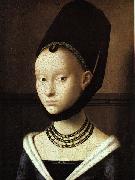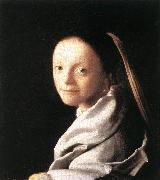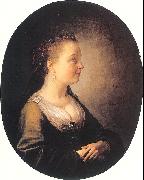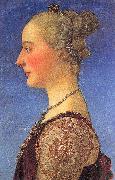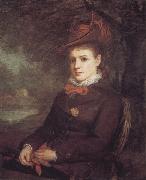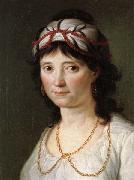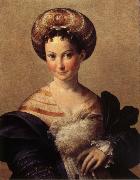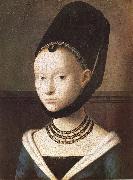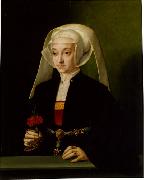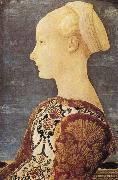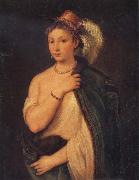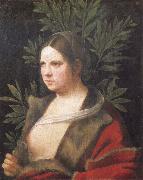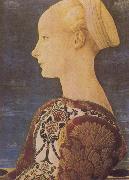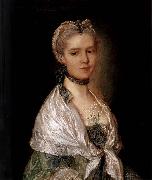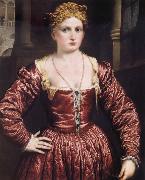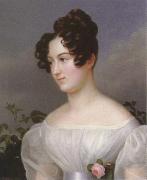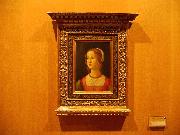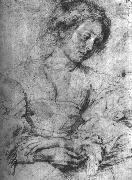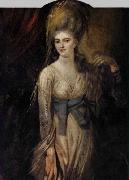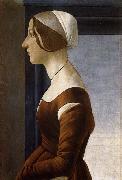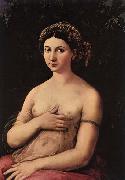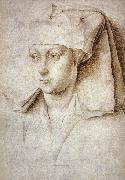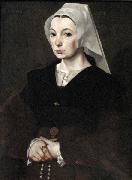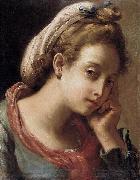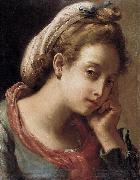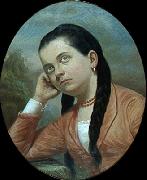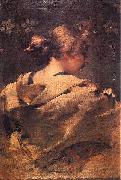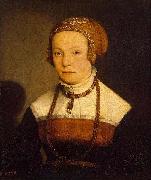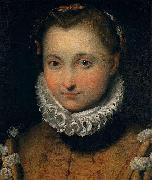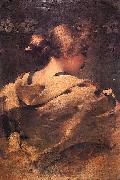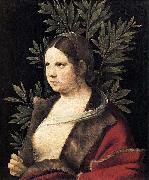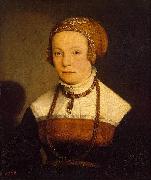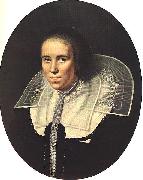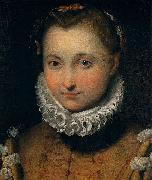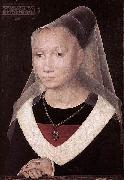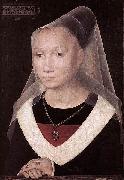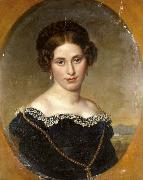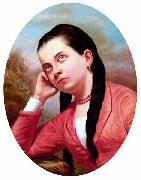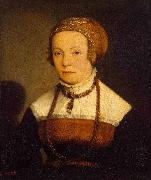Wholesale Oil Painting Reproductions No Minimum and Door to Door! |
|||||||||||
|
|
|||||||||||

|
|||||||||||
|
|
|
||||||||
All Petrus Christus Oil Paintings |
||||||||
|
|
||||||||
|
|
||||||||
|
Artist Introduction: Flemish 1415-1473
Petrus Christus Locations
South Netherlandish painter.
His known artistic career began in Bruges on 6 July 1444 when, as the Poorterboek (citizens register) for that day reveals, he purchased his citizenship ... in order to be a painter. Town records show that he and his wife became members of the Confraternity of the Dry Tree c. 1462; that in 1463 he and another painter, Pieter Nachtegale, were paid for the construction of a Tree of Jesse (destr.) and for the cost of assistants employed on the day of the religious procession in which it was used; and that on 19 March 1472 he served as a representative of the painters guild in a dispute with another painter, Jehan de Hervy the elder ( fl 1472-1507). These and a few other scattered references comprise the existing documentation for Christusa life and work. |
||||||||
|
|
||||||||
|
Portrait of a Young Woman Painting ID:: 405 |
Gemaldegalerie, Berlin |
|||||||
Height Width |
INS/CM Quality |
|||||||
|
X |
| |||||||
|
|
||||||||
All Jan Vermeer Oil Paintings |
||||||||
|
|
||||||||
|
|
||||||||
|
Artist Introduction: Dutch Baroque Era Painter, 1632-1675
Johannes (or Jan) Vermeer is now recognized as one of the great Dutch painters, but while he was alive he could barely make ends meet, and his artistic achievement was almost entirely ignored for 200 years after his death. Little is known about his personal life, other than he died poor and young and left behind a wife and eleven children. Vermeer is admired for his realistic style, his subtle use of color and light and his unusual and inventive brush technique, but fewer than forty of his paintings exist. His most famous works include domestic scenes such as Girl With a Peal Earring (1665) and The Music Lesson (1662-65), and tranquil landscapes such as The Little Street (1657-58) and View of Delft (1659-60). Although his actual birth and death dates are unknown, Vermeer was baptized 31 October 1632 and buried 15 December 1675... During his career he used the names Johannes van der Meer, Johannes Vermeer and Jan Vermeer |
||||||||
|
|
||||||||
|
|
Portrait of a Young Woman Painting ID:: 10280 |
1666-67
Oil on canvas,
44,5 x 40 cm
Metropolitan
Museum of Art,
New York |
||||||
Height Width |
INS/CM Quality |
|||||||
|
X |
| |||||||
|
|
||||||||
All DOU, Gerrit Oil Paintings |
||||||||
|
|
||||||||
|
|
||||||||
|
Artist Introduction: Dutch Baroque Era Painter, 1613-1675
Dutch painter. The first and most famous member of the group of artists referred to as the LEIDEN 'FINE' PAINTERS, he specialized in small-format paintings, the details and surfaces of which are carefully observed and meticulously rendered. He was greatly praised as a painter of artificial light by Samuel van Hoogstraten in 1678, and he was responsible for popularizing both the night scene and the 'niche' format, pictorial devices ultimately derived from the art of his famous master, Rembrandt.
|
||||||||
|
|
||||||||
|
|
Portrait of a Young Woman Painting ID:: 18996 |
1635-40
Oil on panel
Manchester City Art Galleries. |
||||||
Height Width |
INS/CM Quality |
|||||||
|
X |
| |||||||
|
|
||||||||
All Pollaiuolo, Piero Oil Paintings |
||||||||
|
|
||||||||
|
|
||||||||
|
Artist Introduction: Italian, 1443-96 |
||||||||
|
|
||||||||
|
|
Portrait of a Young Woman Painting ID:: 19908 |
1475
Tempera on panel
Galleria degli Uffizi, Florence. |
||||||
Height Width |
INS/CM Quality |
|||||||
|
X |
| |||||||
|
|
||||||||
All John William Waterhouse Oil Paintings |
||||||||
|
|
||||||||
|
|
||||||||
|
Artist Introduction: English Pre-Raphaelite Painter, 1849-1917
English painter. His father was a minor English painter working in Rome. Waterhouse entered the Royal Academy Schools in London in 1870. He exhibited at the Society of British Artists from 1872 and at the Royal Academy from 1874. From 1877 to the 1880s he regularly travelled abroad, particularly to Italy. In the early 1870s he had produced a few uncharacteristic Orientalist keepsake paintings, but most of his works in this period are scenes from ancient history or classical genre subjects, similar to the work of Lawrence Alma-Tadema (e.g. Consulting the Oracle, c. 1882; London, Tate). However, Waterhouse consistently painted on a larger scale than Alma-Tadema. His brushwork is bolder, his sunlight casts harsher shadows and his history paintings are more dramatic. |
||||||||
|
|
||||||||
|
|
Portrait of a Young Woman Painting ID:: 27649 |
mk58
c.1875-8,
oil on canvas
61x50.8cm
|
||||||
Height Width |
INS/CM Quality |
|||||||
|
X |
| |||||||
|
|
||||||||
All Zacarias Gonzalez Velazquez Oil Paintings |
||||||||
|
|
||||||||
|
|
||||||||
|
Artist Introduction: Spanish , Madrid 1763 - 1834 |
||||||||
|
|
||||||||
|
|
Portrait of a Young Woman Painting ID:: 28749 |
mk61
c.1800
Oil on canvas
45x35cm
|
||||||
Height Width |
INS/CM Quality |
|||||||
|
X |
| |||||||
|
|
||||||||
All PARMIGIANINO Oil Paintings |
||||||||
|
|
||||||||
|
|
||||||||
|
Artist Introduction: Italian Mannerist Painter, 1503-1540
Italian painter, draughtsman and printmaker. Beginning a career that was to last only two decades, he moved from precocious success in the shadow of Correggio in Parma to be hailed in the Rome of Clement VII as Raphael reborn. There he executed few large-scale works but was introduced to printmaking. After the Sack of Rome in 1527, he returned to northern Italy, where in his final decade he created some of his most markedly Mannerist works. Equally gifted as a painter of small panels and large-scale frescoes both sacred and profane, he was also one of the most penetrating portrait painters of his age.
|
||||||||
|
|
||||||||
|
|
Portrait of a Young Woman Painting ID:: 30488 |
mk68
Oil on wood
26 1/2x21"
Parma,Nationa Museum
C.1530
Italy
|
||||||
Height Width |
INS/CM Quality |
|||||||
|
X |
| |||||||
|
|
||||||||
All Petrus Christus Oil Paintings |
||||||||
|
|
||||||||
|
|
||||||||
|
Artist Introduction: Flemish 1415-1473
Petrus Christus Locations
South Netherlandish painter.
His known artistic career began in Bruges on 6 July 1444 when, as the Poorterboek (citizens register) for that day reveals, he purchased his citizenship ... in order to be a painter. Town records show that he and his wife became members of the Confraternity of the Dry Tree c. 1462; that in 1463 he and another painter, Pieter Nachtegale, were paid for the construction of a Tree of Jesse (destr.) and for the cost of assistants employed on the day of the religious procession in which it was used; and that on 19 March 1472 he served as a representative of the painters guild in a dispute with another painter, Jehan de Hervy the elder ( fl 1472-1507). These and a few other scattered references comprise the existing documentation for Christusa life and work. |
||||||||
|
|
||||||||
|
|
Portrait of a Young Woman Painting ID:: 31315 |
nn07
after 1446
Panel painting; Gemaldegalerie, Staatliche Museen Preussischer Kulturbesitz at West Berlin
|
||||||
Height Width |
INS/CM Quality |
|||||||
|
X |
| |||||||
|
|
||||||||
All Barthel Bruyn Oil Paintings |
||||||||
|
|
||||||||
|
|
||||||||
|
Artist Introduction: 1493-1555 German
German Renaissance painter, active in Cologne from 1515. Known especially for his portraits, which combine Northern realism with Italian-inspired monumentality and breadth, Bruyn also painted religious works such as the high altar at Essen Cathedral (1522). A portrait of a man and three religious works are in the Philadelphia Museum; many of his works are in Germany. |
||||||||
|
|
||||||||
|
|
Portrait of a Young Woman Painting ID:: 32265 |
Oil on canvas |
||||||
Height Width |
INS/CM Quality |
|||||||
|
X |
| |||||||
|
|
||||||||
All DOMENICO VENEZIANO Oil Paintings |
||||||||
|
|
||||||||
|
|
||||||||
|
Artist Introduction: Italian Early Renaissance Painter, ca.1400-1461
|
||||||||
|
|
||||||||
|
|
Portrait of a Young Woman Painting ID:: 33371 |
mk86
c.1465
Tempera on wood
52.5x36.5cm
|
||||||
Height Width |
INS/CM Quality |
|||||||
|
X |
| |||||||
|
|
||||||||
All Titian Oil Paintings |
||||||||
|
|
||||||||
|
|
||||||||
|
Artist Introduction: Italian High Renaissance Painter, ca.1485-1576
Italian painter active in Venice. As a young man he was taught by the Bellini family and worked closely with Giorgione. His early works are so similar in style to Giorgione's as to be indistinguishable, but soon after Giorgione's early death Titian established himself as the leading painter of the Republic of Venice. Among his most important religious paintings is the revolutionary and monumental Assumption (1516 ?C 18) for Santa Maria dei Frari, in which the Virgin ascends to heaven in a blaze of colour accompanied by a semicircle of angels. Titian was also interested in mythological themes, and his many depictions of Venus display his work's sheer beauty and inherent eroticism. Bacchus and Ariadne (1520 ?C 23), with its pagan abandon, is one of the greatest works of Renaissance art. Titian was sought after for his psychologically penetrating portraits, which include portrayals of leading Italian aristocrats, religious figures, and Emperor Charles V. He reached the height of his powers in The Rape of Europa (c. 1559 ?C 62), one of several paintings done for Philip II of Spain. He was recognized as supremely gifted in his lifetime, and his reputation has never declined. |
||||||||
|
|
||||||||
|
|
Portrait of a Young Woman Painting ID:: 34262 |
mk91
1530s
Oil on canvas
96x85
|
||||||
Height Width |
INS/CM Quality |
|||||||
|
X |
| |||||||
|
|
||||||||
All Giorgione Oil Paintings |
||||||||
|
|
||||||||
|
|
||||||||
|
Artist Introduction: Italian
1476-1510
Giorgione Galleries
For his home town of Castelfranco, Giorgione painted the Castelfranco Madonna, an altarpiece in sacra conversazione form ?? Madonna enthroned, with saints on either side forming an equilateral triangle. This gave the landscape background an importance which marks an innovation in Venetian art, and was quickly followed by his master Giovanni Bellini and others.Giorgione began to use the very refined chiaroscuro called sfumato ?? the delicate use of shades of color to depict light and perspective ?? around the same time as Leonardo. Whether Vasari is correct in saying he learnt it from Leonardo's works is unclear ?? he is always keen to ascribe all advances to Florentine sources. Leonardo's delicate color modulations result from the tiny disconnected spots of paint that he probably derived from manuscript illumination techniques and first brought into oil painting. These gave Giorgione's works the magical glow of light for which they are celebrated.
Most entirely central and typical of all Giorgione's extant works is the Sleeping Venus now in Dresden, first recognized by Morelli, and now universally accepted, as being the same as the picture seen by Michiel and later by Ridolfi (his 17th century biographer) in the Casa Marcello at Venice. An exquisitely pure and severe rhythm of line and contour chastens the sensuous richness of the presentment: the sweep of white drapery on which the goddess lies, and of glowing landscape that fills the space behind her, most harmoniously frame her divinity. The use of an external landscape to frame a nude is innovative; but in addition, to add to her mystery, she is shrouded in sleep, spirited away from accessibility to her conscious expression.
It is recorded by Michiel that Giorgione left this piece unfinished and that the landscape, with a Cupid which subsequent restoration has removed, were completed after his death by Titian. The picture is the prototype of Titian's own Venus of Urbino and of many more by other painters of the school; but none of them attained the fame of the first exemplar. The same concept of idealized beauty is evoked in a virginally pensive Judith from the Hermitage Museum, a large painting which exhibits Giorgione's special qualities of color richness and landscape romance, while demonstrating that life and death are each other's companions rather than foes.
Apart from the altarpiece and the frescoes, all Giorgione's surviving works are small paintings designed for the wealthy Venetian collector to keep in his home; most are under two foot (60 cm) in either dimension. This market had been emerging over the last half of the fifteenth century in Italy, and was much better established in the Netherlands, but Giorgione was the first major Italian painter to concentrate his work on it to such an extent ?? indeed soon after his death the size of such paintings began to increase with the prosperity and palaces of the patrons. |
||||||||
|
|
||||||||
|
|
Portrait of a young woman Painting ID:: 39587 |
mk150
1506
Canvas on panel
41x33.6cm
|
||||||
Height Width |
INS/CM Quality |
|||||||
|
X |
| |||||||
|
|
||||||||
All DOMENICO VENEZIANO Oil Paintings |
||||||||
|
|
||||||||
|
|
||||||||
|
Artist Introduction: Italian Early Renaissance Painter, ca.1400-1461
|
||||||||
|
|
||||||||
|
|
Portrait of a Young Woman Painting ID:: 40218 |
mk156
c.1465
Oil on panel
51x35cm |
||||||
Height Width |
INS/CM Quality |
|||||||
|
X |
| |||||||
|
|
||||||||
All Thomas Gainsborough Oil Paintings |
||||||||
|
|
||||||||
|
|
||||||||
|
Artist Introduction: 1727-1788
British
Thomas Gainsborough Locations
English painter, draughtsman and printmaker. He was the contemporary and rival of Joshua Reynolds, who honoured him on 10 December 1788 with a valedictory Discourse (pubd London, 1789), in which he stated: If ever this nation should produce genius sufficient to acquire to us the honourable distinction of an English School, the name of Gainsborough will be transmitted to posterity, in the history of Art, among the very first of that rising name. He went on to consider Gainsborough portraits, landscapes and fancy pictures within the Old Master tradition, against which, in his view, modern painting had always to match itself. Reynolds was acknowledging a general opinion that Gainsborough was one of the most significant painters of their generation. Less ambitious than Reynolds in his portraits, he nevertheless painted with elegance and virtuosity. He founded his landscape manner largely on the study of northern European artists and developed a very beautiful and often poignant imagery of the British countryside. By the mid-1760s he was making formal allusions to a wide range of previous art, from Rubens and Watteau to, eventually, Claude and Titian. He was as various in his drawings and was among the first to take up the new printmaking techniques of aquatint and soft-ground etching. Because his friend, the musician and painter William Jackson (1730-1803), claimed that Gainsborough detested reading, there has been a tendency to deny him any literacy. He was, nevertheless, as his surviving letters show, verbally adept, extremely witty and highly cultured. He loved music and performed well. He was a person of rapidly changing moods, humorous, brilliant and witty. At the time of his death he was expanding the range of his art, having lived through one of the more complex and creative phases in the history of British painting. He painted with unmatched skill and bravura; while giving the impression of a kind of holy innocence, he was among the most artistically learned and sophisticated painters of his generation. It has been usual to consider his career in terms of the rivalry with Reynolds that was acknowledged by their contemporaries; while Reynolds maintained an intellectual and academic ideal of art, Gainsborough grounded his imagery on contemporary life, maintaining an aesthetic outlook previously given its most powerful expression by William Hogarth. His portraits, landscapes and subject pictures are only now coming to be studied in all their complexity; having previously been viewed as being isolated from the social, philosophical and ideological currents of their time, they have yet to be fully related to them. It is clear, however, that his landscapes and rural pieces, and some of his portraits, were as significant as Reynolds acknowledged them to be in 1788. |
||||||||
|
|
||||||||
|
|
Portrait of a Young Woman Painting ID:: 40955 |
mk158
c.1759
|
||||||
Height Width |
INS/CM Quality |
|||||||
|
X |
| |||||||
|
|
||||||||
All Paris Bordone Oil Paintings |
||||||||
|
|
||||||||
|
|
||||||||
|
Artist Introduction: Italian
1500-1571
Italian painter and draughtsman. He is best known for his strikingly beautiful depictions of women, both in portraits and in cabinet paintings. He also excelled in rendering monumental architectural settings for narrative, both religious and secular, possibly initiating a genre that would find great currency during the mid-16th century, especially in Venice, France and the Netherlands. His favoured media were oil and fresco, the latter being used on both interiors and faades. Although he was not generally sought after by Venetian patrons during his career, as his art was eclipsed by that of Titian, Paolo Veronese and Jacopo Tintoretto, Bordone was regarded in the mid-16th century as an accomplished artist (Pino; Sansovino). He worked for the moneyed lite of northern Italy and Bavaria, for the royalty of France and Poland, and had works commissioned to be sent to Spain and to Flanders. Despite knowledge of the important patrons for whom he worked, the chronology of Bordones oeuvre is by no means clear. Dating on stylistic grounds is confounded by the diverse sources on which he drew, ranging from the Emilian, Lombard and Venetian to the French and northern European, depending on the patron. Due to the ease with which prints circulated during Bordones career, it is difficult to ascertain whether influences were derived at first hand or from printed images. Such difficulties in assigning dates are further exacerbated by his use of the same figure study for numerous paintings evidently executed decades apart. Reliance on the testimony of Vasari, who interviewed Bordone in 1566, in conjunction with the extant documents, the few signed and dated paintings and, to a lesser extent, period fashion provides only a rough outline of his activity. Due to the lack of agreement among scholars regarding chronology, the following account is based mainly on the documentary evidence. |
||||||||
|
|
||||||||
|
|
Portrait of a Young Woman Painting ID:: 43048 |
mk170
Oil on canvas
106.7x85.7cm
|
||||||
Height Width |
INS/CM Quality |
|||||||
|
X |
| |||||||
|
|
||||||||
All Bischoff, Franz Oil Paintings |
||||||||
|
|
||||||||
|
|
||||||||
|
Artist Introduction: Austrian, practiced mainly in America, 1864-1929
was an American artist known primarily for his beautiful floral paintings and California landscapes. He was born in Bomen, Austria on January 9, 1864 and as a young teenager immigrated to the United States where he became a naturalized citizen. While in Europe, his early training was focused upon applied design, watercolor and ceramic decorations.After having lived and worked in New York, Fostoria, Ohio and Dearborn, Michigan, Franz Bischoff decided to visit California in 1900 and ultimately chose to settle in Los Angeles in 1906. Shortly after arriving, he started making arrangements to design and build a large Italian Renaissance style home in Pasadena that also became his studio. This landmark home was completed in 1908. Inspired by the California countryside, Bischoff set attempted to capture the area's brilliant light and diverse landscapes. Spending less time with ceramic painting, Bischoff painted local farms, fishing wharfs, and coastal landscapes. Recognized during his career for use of color and vivid composition, his paintings always displayed reverence for nature. |
||||||||
|
|
||||||||
|
|
portrait of a young woman Painting ID:: 56199 |
mk247
1827,oil on canvas,24.625x20.625 in,62.5x52.5 cm,private collection |
||||||
Height Width |
INS/CM Quality |
|||||||
|
X |
| |||||||
|
|
||||||||
All Domenico Ghirlandaio Oil Paintings |
||||||||
|
|
||||||||
|
|
||||||||
|
Artist Introduction: Italian
1449-1494
Domenico Ghirlandaio Galleries
Painter, mosaicist and possibly goldsmith. He was head of one of the most active workshops in late 15th-century Florence. He developed a style of religious narrative that blended the contemporary with the historical in a way that updated the basic tenets of early Renaissance art. Domenico documented material situation |
||||||||
|
|
||||||||
|
|
Portrait of a Young Woman Painting ID:: 59053 |
Portrait of a Young Woman |
||||||
Height Width |
INS/CM Quality |
|||||||
|
X |
| |||||||
|
|
||||||||
All Peter Paul Rubens Oil Paintings |
||||||||
|
|
||||||||
|
|
||||||||
|
Artist Introduction: Flemish Baroque Era Painter, 1577-1640
Peter Paul Rubens (June 28, 1577 ?C May 30, 1640) was a prolific seventeenth-century Flemish Baroque painter, and a proponent of an exuberant Baroque style that emphasized movement, color, and sensuality. He is well-known for his Counter-Reformation altarpieces, portraits, landscapes, and history paintings of mythological and allegorical subjects.
In addition to running a large studio in Antwerp which produced paintings popular with nobility and art collectors throughout Europe, Rubens was a classically-educated humanist scholar, art collector, and diplomat who was knighted by both Philip IV, king of Spain, and Charles I, king of England.
Rubens was a prolific artist. His commissioned works were mostly religious subjects, "history" paintings, which included mythological subjects, and hunt scenes. He painted portraits, especially of friends, and self-portraits, and in later life painted several landscapes. Rubens designed tapestries and prints, as well as his own house. He also oversaw the ephemeral decorations of the Joyous Entry into Antwerp by the Cardinal-Infante Ferdinand in 1635.
His drawings are mostly extremely forceful but not detailed; he also made great use of oil sketches as preparatory studies. He was one of the last major artists to make consistent use of wooden panels as a support medium, even for very large works, but he used canvas as well, especially when the work needed to be sent a long distance. For altarpieces he sometimes painted on slate to reduce reflection problems.
His fondness of painting full-figured women gave rise to the terms 'Rubensian' or 'Rubenesque' for plus-sized women. The term 'Rubensiaans' is also commonly used in Dutch to denote such women. |
||||||||
|
|
||||||||
|
|
Portrait of a Young Woman Painting ID:: 62441 |
1628-35 Black chalk Museum Boijmans Van Beuningen, Rotterdam Author: RUBENS, Pieter Pauwel Title: Portrait of a Young Woman , 1601-1650 , Flemish Form: graphics , portrait |
||||||
Height Width |
INS/CM Quality |
|||||||
|
X |
| |||||||
|
|
||||||||
All Johann Heinrich Fuseli Oil Paintings |
||||||||
|
|
||||||||
|
|
||||||||
|
Artist Introduction: 1741-1825
Romanticism Swiss
|
||||||||
|
|
||||||||
|
|
Portrait of a Young Woman Painting ID:: 62845 |
101 x 127 cm Institue of Arts, Detroit This portrait is painted on the reverse of the Nightmare. The portrait is generally believed to be of the woman Fuseli loved, Anna Landolt, who was a niece of the Zerich physiologist Johann Caspar Lavater (1741-1801). Lavater and Fuseli were close friends, but Fuseli's suit was rejected by Anna's parents, and it may not be coincidence that the portrait is on the reverse of his painting The Nightmare. Artist: FUSELI, John Henry Title: Portrait of a Young Woman , painting Date: 1751-1800 Swiss : portrait |
||||||
Height Width |
INS/CM Quality |
|||||||
|
X |
| |||||||
|
|
||||||||
All BOTTICELLI, Sandro Oil Paintings |
||||||||
|
|
||||||||
|
|
||||||||
|
Artist Introduction: Italian Early Renaissance Painter, 1445-1510
Alessandro di Mariano di Vanni Filipepi, better known as Sandro Botticelli or Il Botticello ("The Little Barrel"; March 1, 1445 ?C May 17, 1510) was an Italian painter of the Florentine school during the Early Renaissance (Quattrocento). Less than a hundred years later, this movement, under the patronage of Lorenzo de' Medici, was characterized by Giorgio Vasari as a "golden age", a thought, suitably enough, he expressed at the head of his Vita of Botticelli. His posthumous reputation suffered until the late 19th century; since then his work has been seen to represent the linear grace of Early Renaissance painting, and The Birth of Venus and Primavera rank now among the most familiar masterpieces of Florentine art.
Details of Botticelli's life are sparse, but we know that he became an apprentice when he was about fourteen years old, which would indicate that he received a fuller education than did other Renaissance artists. Vasari reported that he was initially trained as a goldsmith by his brother Antonio. Probably by 1462 he was apprenticed to Fra Filippo Lippi; many of his early works have been attributed to the elder master, and attributions continue to be uncertain. Influenced also by the monumentality of Masaccio's painting, it was from Lippi that Botticelli learned a more intimate and detailed manner. As recently discovered, during this time, Botticelli could have traveled to Hungary, participating in the creation of a fresco in Esztergom, ordered in the workshop of Fra Filippo Lippi by Vitez J??nos, then archbishop of Hungary.
By 1470 Botticelli had his own workshop. Even at this early date his work was characterized by a conception of the figure as if seen in low relief, drawn with clear contours, and minimizing strong contrasts of light and shadow which would indicate fully modeled forms. |
||||||||
|
|
||||||||
|
|
Portrait of a Young Woman Painting ID:: 62943 |
1475 Tempera on panel, 61 x 40 cm Galleria Palatina (Palazzo Pitti), Florence There are several assumptions concerning the identity of the young woman (Simonetta Vespucci, Clarice Orsini, Fioretta Gorini etc.). The picture was partly repainted. The sleeve of the robe covers the left hand in a very unnatural way. The lock of hair coming loose from her bun gives a more spontaneous feeling to this severe profile portrait. The half length figure is slightly to the left of the centre of the picture. Behind her is a dark window frame and it contrasts with the gentle flow other contours. The attribution of the work to Botticelli is disputed. Artist: BOTTICELLI, Sandro Painting Title: Portrait of a Young Woman , 1451-1500 Painting Style: Italian , , portrait |
||||||
Height Width |
INS/CM Quality |
|||||||
|
X |
| |||||||
|
|
||||||||
All RAFFAELLO Sanzio Oil Paintings |
||||||||
|
|
||||||||
|
|
||||||||
|
Artist Introduction: Italian High Renaissance Painter, 1483-1520
Italian painter and architect. As a member of Perugino's workshop, he established his mastery by 17 and began receiving important commissions. In 1504 he moved to Florence, where he executed many of his famous Madonnas; his unity of composition and suppression of inessentials is evident in The Madonna of the Goldfinch (c. 1506). Though influenced by Leonardo da Vinci's chiaroscuro and sfumato, his figure types were his own creation, with round, gentle faces that reveal human sentiments raised to a sublime serenity. In 1508 he was summoned to Rome to decorate a suite of papal chambers in the Vatican. The frescoes in the Stanza della Segnatura are probably his greatest work; the most famous, The School of Athens (1510 C 11), is a complex and magnificently ordered allegory of secular knowledge showing Greek philosophers in an architectural setting. The Madonnas he painted in Rome show him turning away from his earlier work's serenity to emphasize movement and grandeur, partly under Michelangelo's High Renaissance influence. The Sistine Madonna (1513) shows the richness of colour and new boldness of compositional invention typical of his Roman period. He became the most important portraitist in Rome, designed 10 large tapestries to hang in the Sistine Chapel, designed a church and a chapel, assumed the direction of work on St. Peter's Basilica at the death of Donato Bramante, |
||||||||
|
|
||||||||
|
|
Portrait of a Young Woman Painting ID:: 63786 |
1518-19 Oil on wood, 85 x 60 cm Galleria Nazionale d'Arte Antica, Rome Much of Raphael's energy during his last years was directed toward public activity, or at least toward commissioners who were influential in city life and life within the Papal States (he designed a villa, known as the Villa Madama, for Cardinal Giulio de' Medici). Furthermore, many critics attribute to him a series of compositions of the Holy Family and of Saints which were then executed by his followers. The famous portrait of a young woman, called La Fornarina, must also be viewed in this perspective, although it is signed, in Latin, "Raphael from Urbino". The signature is engraved on the thin ribbon that the girl wears just under her left shoulder. Tradition identifies her with Margherita Luti, a Sienese woman whom Raphael loved, the daughter of a baker from the Roman district of Santa Dorotea. The stiffness of her features and the heavy chiaroscuro effect make La Fornarina an almost certain workshop piece with the contribution of Raphael, for Raphael's own work from this period is far more delicate. There are several old copies of this painting, the most famous in the Galleria Borghese.Artist:RAFFAELLO Sanzio Title: Portrait of a Young Woman (La Fornarina) Painted in 1501-1550 , Italian - - painting : portrait |
||||||
Height Width |
INS/CM Quality |
|||||||
|
X |
| |||||||
|
|
||||||||
All WEYDEN, Rogier van der Oil Paintings |
||||||||
|
|
||||||||
|
|
||||||||
|
Artist Introduction: Netherlandish Northern Renaissance Painter, ca.1400-1464
major early Flemish master, known also as Roger de la Pasture. He is believed to have studied with Robert Campin. His early works also show the influence of Jan van Eyck. Van Eyck, however, had been a master at objective rendering of detail, whereas Roger in his work portrayed emotions with an assurance that has not been surpassed. His ability to depict piety is reflected in the early masterpiece Descent from the Cross (c.1435; Prado); he depicted with significant restraint the profound grief of the mourners grouped around the tragic figure of Jesus. His composition strongly affected later representations of the theme. Roger became City Painter in Brussels in 1436. He then produced a series of undated altarpieces including the Last Judgment (hospital, Beaune), the Braque Triptych (Louvre), Crucifixion with Donors (Vienna), and Adoration of the Magi (Berlin), which vary in execution from a stress on sumptuous details to a more sculptural rendering of the figures. Roger is believed to have made a pilgrimage to Italy in the holy year 1450. Whether this supposed excursion had any effect on his style is much debated. It has been shown that his Entombment (Uffizi) bears an affinity to the Tuscan treatment of the subject, particularly by Fra Angelico, and that Roger's Virgin and Child with Saints (Frankfurt) has a strong resemblance to the Italian religious art of the day. His style is, however, highly individual. His religious paintings and his portraits are characterized by a straightforward monumentality. The portraits, such as that of a young lady (National Gall. of Art, Washington, D.C.) and of Francesco d'Este (Metropolitan Mus.) exhibit a simple clarity of contour and psychological penetration. Other notable works are his St. Luke Painting the Virgin, of which a version or replica is in the Museum of Fine Arts, Boston, the Crucifixion |
||||||||
|
|
||||||||
|
|
Portrait of a Young Woman Painting ID:: 63866 |
1440 Silverpoint on prepared paper, 166 x 116 mm British Museum, London The finest of the drawings ascribed to Rogier is the Portrait of a Young Woman. In its freshness of observation and lively expression the drawing comes closest to the painted portrait of another young woman (Staatliche Museen, Berlin), although in contrast to that painting - probably the earliest of the independent portraits by Rogier still extant - the draftsman has modeled the face with much greater plasticity, using light and shade to make shapes like the eyelids appear more rounded and fleshier. This factor in turn links the drawing closely to a portrait of a woman ascribed to the Master of Fl?malle, now in the National Gallery, London, and to the faces in Rogier's earlier Deposition (Prado, Madrid). The strong, bright reflections on the shaded areas of the sitter's throat and cheeks also adopt a method frequently used by Jan van Eyck to heighten the sense of three-dimensionality. By comparison with the chiaroscuro and the powerful three-dimensional style of the drawing, the painted face of the young woman in the portrait appear generally more linear - paradoxically, one might almost say more like a drawing. The draftsman's intention of placing several strong contrasts of light and shade side by side also matches the effects in the Deposition. Like the shaded side of the head of the Virgin, the right-hand side of the portrait drawing shows the alternation of light and very dark areas, and the artist has even shaded the headdress heavily next to the area of reflected light on the sitter's jaw line just below her ear, though this effect is illogical, since if the head-dress is to reflect light it ought to be lit there itself. However, the darkness in the outer area of the drawing, emphasizing the fold at the back of the head-dress, is a genuinely distinctive feature, producing the effect of heavy shadow. There are no such heavy shadows in any painted portrait by Rogier; this pictorial device, creating a sense of space around the figure, first appears in painting around the middle of the century in works by the artist Petrus Christus, who was active in Bruges. Here the draftsman may have created the shadows before drawing the sitter herself, or he may have placed them there to make the back of the headdress retreat into the background - an effect that would also be achieved by the uniform dark ground of a painted portrait. The immediacy of this portrait gives the impression that it was drawn from life. Such an impression is further supported by the fact that only the head and the complicated head-dress are executed in detail, while the upper part of the sitter's body is only lightly indicated; her dress with its patterns of folds could be added later, and leaving it out while the woman herself was being portrayed would have spared her the tedium of sitting for the artist. Such details could easily enough be copied from a painting, but the visible part of the woman's body appears rather awkwardly executed. The right hand on the edge of the picture is particularly jarring, and does not quite connect up anatomically with her shoulder. It is complex in structure, but only half shown, and its clear outline does not make it look like a study from nature. Perhaps the artist completed the lower areas of the portrait later, using a work already in his stock, and experimenting with the composition of his planned painting. All Early Netherlandish portraits were certainly based on drawings from life, for the long process of painting would not have allowed the artist to work from a living model. The Portrait of a Young Woman, outstanding as both a drawing and a portrait, must be one of the very few examples of this genre to have been preserved. Since over and beyond these qualities, the drawing shows similarities with Rogier's painted portraits in its presentation, and with his Deposition in the manner of depicting a head, it could well be by his own hand. It was probably done quite close to the time of the great altarpiece for the Archers of Leuven, while the other (painted) Portrait of a Young Woman must have been executed rather later.Artist:WEYDEN, Rogier van der Title: Portrait of a Young Woman Painted in 1401-1450 , Flemish - - graphics : portrait |
||||||
Height Width |
INS/CM Quality |
|||||||
|
X |
| |||||||
|
|
||||||||
All Master of the Legend Oil Paintings |
||||||||
|
|
||||||||
|
|
||||||||
|
Artist Introduction: active in Cologne ca 1490/1500
Austrian painter and woodcutter. He is named after two altarpiece wings with three scenes from the Legend of SS Cosmas and Damian: the Miraculous Healing of the Leg, A Husband Commending his Wife to the Saints and the Delivery of the False Message by the Devil (Vienna, Ksthist. Mus.). He is thought to have been the earliest disciple of Lucas Cranach the elder in Austria and to have been later influenced by both Albrecht Altdorfer and J?rg Breu the elder. His rather stately figures are in splayed-out, often affected poses, with the feet and knees twisted outwards, appearing almost dislocated. |
||||||||
|
|
||||||||
|
|
Portrait of a young woman Painting ID:: 71551 |
Date 1541(1541)
Medium Oil on oak panel
|
||||||
Height Width |
INS/CM Quality |
|||||||
|
X |
| |||||||
|
|
||||||||
All Gaetano Gandolfi Oil Paintings |
||||||||
|
|
||||||||
|
|
||||||||
|
Artist Introduction: (August 31, 1734 - June 20, 1802) was an Italian painter of the late Baroque and early Neoclassic period, active in Bologna.
Gaetano was born in San Matteo della Decima, near Bologna, to a family of artists. Ubaldo Gandolfi was his brother, Mauro Gandolfi was his son, and Democrito Gandolfi was his grandson. Gaetano became a "student" at the Accademia Clementina in Bologna, where he was taught by Felice Torelli and Ercole Lelli. In the academy, he was the recipient of several prizes for both figure drawing and sculpture. Later, in an autobiography, Gaetano claimed Felice Torelli (1667 - 1748) as his master. Other sources mention Ercole Graziani the Younger (1688 - 1765) and Ercole Lelli. He traveled to England, and became strongly influenced by Tiepolo. Gaetano died in Bologna, Italy.
|
||||||||
|
|
||||||||
|
|
Portrait of a Young Woman Painting ID:: 74528 |
1777
Oil on canvas
51 X 40 cm (20.08 X 15.75 in)
cjr |
||||||
Height Width |
INS/CM Quality |
|||||||
|
X |
| |||||||
|
|
||||||||
All Gaetano Gandolfi Oil Paintings |
||||||||
|
|
||||||||
|
|
||||||||
|
Artist Introduction: (August 31, 1734 - June 20, 1802) was an Italian painter of the late Baroque and early Neoclassic period, active in Bologna.
Gaetano was born in San Matteo della Decima, near Bologna, to a family of artists. Ubaldo Gandolfi was his brother, Mauro Gandolfi was his son, and Democrito Gandolfi was his grandson. Gaetano became a "student" at the Accademia Clementina in Bologna, where he was taught by Felice Torelli and Ercole Lelli. In the academy, he was the recipient of several prizes for both figure drawing and sculpture. Later, in an autobiography, Gaetano claimed Felice Torelli (1667 - 1748) as his master. Other sources mention Ercole Graziani the Younger (1688 - 1765) and Ercole Lelli. He traveled to England, and became strongly influenced by Tiepolo. Gaetano died in Bologna, Italy.
|
||||||||
|
|
||||||||
|
|
Portrait of a Young Woman Painting ID:: 76063 |
Date 1777
Medium Oil on canvas
Dimensions 51 ?? 40 cm (20.1 ?? 15.7 in)
cyf |
||||||
Height Width |
INS/CM Quality |
|||||||
|
X |
| |||||||
|
|
||||||||
All Almeida Junior Oil Paintings |
||||||||
|
|
||||||||
|
|
||||||||
|
Artist Introduction: (8 May 1850 ?C 13 November 1899) was a Brazilian painter of the 19th century. He is widely regarded as the most important Brazilian realist painter of the 19th century, and a major inspiration for the modernist painters. While most Brazilian academic artists made their fame painting mythological or historical subjects, Almeida Junior would become popular for painting rural figures, especially farmers and the caipira, the countrymen that are a kind of a symbol of the rural areas of the São Paulo state.
While most realist painters used farmers and countrymen as an allegory of workers, Almeida Junior would paint his caipiras mostly on leisure time. He would also produce touching images of upscale landowners. The Bandeirantes, the ruthless explorers of colonial Brazil, would be depicted in the A partida da monção, showing an expedition on the Tiet?? River.
Almeida Junior was born in the city of Itu, then a small town in the state of São Paulo. After becoming a sensation in his town he would be invited to study in the Brazilian Imperial Fine Arts Academy of Rio de Janeiro, but in 1876 would study in France after being granted a scholarship by emperor Pedro II of Brazil in person in the city of Moji-Mirim. He would have Alexandre Cabanel as one of his masters.
He admired the French realist and naturalist painting (a major influence at his work), and, after returning to Brazil in 1882, became of the leading names in Brazilian realist painting.
He was stabbed to death by the husband of his mistress on November 13, 1899 in Piracicaba.
|
||||||||
|
|
||||||||
|
|
Portrait of a young woman Painting ID:: 81497 |
Medium Oil on cardboard
Dimensions 61 x 46 cm (24 x 18.1 in)
cjr |
||||||
Height Width |
INS/CM Quality |
|||||||
|
X |
| |||||||
|
|
||||||||
All Franciszek zmurko Oil Paintings |
||||||||
|
|
||||||||
|
|
||||||||
|
Artist Introduction: (18 July 1859 in Lviv - 9 October 1910 in Warsaw) was a Polish painter. Zmurko began drawing lessons as a young boy in his hometown with the painter Franciszek Tepa. As an adolescent he moved to Krakow to study at the The Academy of Fine Arts where he had lessons from Jan Matejko. In 1877 Zmurko moved to Vienna, Austria where he was accepted at the Vienna Academy, but left soon thereafter to study under Aleksander Wagner in Munich. Zmurko returned to Krakow in 1880 and then moved to Warsaw in 1882 where he remained until his death in 1910.
|
||||||||
|
|
||||||||
|
|
Portrait of a Young Woman Painting ID:: 82023 |
oil on canvas
Dimensions 98 x 64 cm (38.6 x 25.2 in)
1896
cjr |
||||||
Height Width |
INS/CM Quality |
|||||||
|
X |
| |||||||
|
|
||||||||
All Christoph Amberger Oil Paintings |
||||||||
|
|
||||||||
|
|
||||||||
|
Artist Introduction: (c. 1505 --1562) was a painter of Nernberg in the 16th century, a disciple of Hans Holbein, his principal work being the history of Joseph in twelve pictures.
Amberger travelled to Northern Italy and Venice between 1525 and 1527. He died in Augsburg.
|
||||||||
|
|
||||||||
|
|
Portrait of a Young Woman Painting ID:: 84662 |
Date after 1548(1548)
Medium Oil on wood
Dimensions Height: 51 cm (20.1 in). Width: 43 cm (16.9 in).
cjr |
||||||
Height Width |
INS/CM Quality |
|||||||
|
X |
| |||||||
|
|
||||||||
All Federico Barocci Oil Paintings |
||||||||
|
|
||||||||
|
|
||||||||
|
Artist Introduction: Italian Mannerist/Baroque Era Painter, ca.1535-1612 |
||||||||
|
|
||||||||
|
|
Portrait of a Young Woman Painting ID:: 85585 |
Date between 1570(1570) and 1575(1575)
Medium Oil on paper
Dimensions Height: 45 cm (17.7 in). Width: 33 cm (13 in).
cjr |
||||||
Height Width |
INS/CM Quality |
|||||||
|
X |
| |||||||
|
|
||||||||
All Franciszek zmurko Oil Paintings |
||||||||
|
|
||||||||
|
|
||||||||
|
Artist Introduction: (18 July 1859 in Lviv - 9 October 1910 in Warsaw) was a Polish painter. Zmurko began drawing lessons as a young boy in his hometown with the painter Franciszek Tepa. As an adolescent he moved to Krakow to study at the The Academy of Fine Arts where he had lessons from Jan Matejko. In 1877 Zmurko moved to Vienna, Austria where he was accepted at the Vienna Academy, but left soon thereafter to study under Aleksander Wagner in Munich. Zmurko returned to Krakow in 1880 and then moved to Warsaw in 1882 where he remained until his death in 1910.
|
||||||||
|
|
||||||||
|
|
Portrait of a Young Woman Painting ID:: 85812 |
oil on canvas
Dimensions 98 x 64 cm (38.6 x 25.2 in)
cyf |
||||||
Height Width |
INS/CM Quality |
|||||||
|
X |
| |||||||
|
|
||||||||
All Giorgione Oil Paintings |
||||||||
|
|
||||||||
|
|
||||||||
|
Artist Introduction: Italian
1476-1510
Giorgione Galleries
For his home town of Castelfranco, Giorgione painted the Castelfranco Madonna, an altarpiece in sacra conversazione form ?? Madonna enthroned, with saints on either side forming an equilateral triangle. This gave the landscape background an importance which marks an innovation in Venetian art, and was quickly followed by his master Giovanni Bellini and others.Giorgione began to use the very refined chiaroscuro called sfumato ?? the delicate use of shades of color to depict light and perspective ?? around the same time as Leonardo. Whether Vasari is correct in saying he learnt it from Leonardo's works is unclear ?? he is always keen to ascribe all advances to Florentine sources. Leonardo's delicate color modulations result from the tiny disconnected spots of paint that he probably derived from manuscript illumination techniques and first brought into oil painting. These gave Giorgione's works the magical glow of light for which they are celebrated.
Most entirely central and typical of all Giorgione's extant works is the Sleeping Venus now in Dresden, first recognized by Morelli, and now universally accepted, as being the same as the picture seen by Michiel and later by Ridolfi (his 17th century biographer) in the Casa Marcello at Venice. An exquisitely pure and severe rhythm of line and contour chastens the sensuous richness of the presentment: the sweep of white drapery on which the goddess lies, and of glowing landscape that fills the space behind her, most harmoniously frame her divinity. The use of an external landscape to frame a nude is innovative; but in addition, to add to her mystery, she is shrouded in sleep, spirited away from accessibility to her conscious expression.
It is recorded by Michiel that Giorgione left this piece unfinished and that the landscape, with a Cupid which subsequent restoration has removed, were completed after his death by Titian. The picture is the prototype of Titian's own Venus of Urbino and of many more by other painters of the school; but none of them attained the fame of the first exemplar. The same concept of idealized beauty is evoked in a virginally pensive Judith from the Hermitage Museum, a large painting which exhibits Giorgione's special qualities of color richness and landscape romance, while demonstrating that life and death are each other's companions rather than foes.
Apart from the altarpiece and the frescoes, all Giorgione's surviving works are small paintings designed for the wealthy Venetian collector to keep in his home; most are under two foot (60 cm) in either dimension. This market had been emerging over the last half of the fifteenth century in Italy, and was much better established in the Netherlands, but Giorgione was the first major Italian painter to concentrate his work on it to such an extent ?? indeed soon after his death the size of such paintings began to increase with the prosperity and palaces of the patrons. |
||||||||
|
|
||||||||
|
|
Portrait of a Young Woman Painting ID:: 86880 |
Date 1506(1506)
Medium Oil on canvas mounted on panel
Dimensions Height: 41 cm (16.1 in). Width: 34 cm (13.4 in).
cjr |
||||||
Height Width |
INS/CM Quality |
|||||||
|
X |
| |||||||
|
|
||||||||
All Christoph Amberger Oil Paintings |
||||||||
|
|
||||||||
|
|
||||||||
|
Artist Introduction: (c. 1505 --1562) was a painter of Nernberg in the 16th century, a disciple of Hans Holbein, his principal work being the history of Joseph in twelve pictures.
Amberger travelled to Northern Italy and Venice between 1525 and 1527. He died in Augsburg.
|
||||||||
|
|
||||||||
|
|
Portrait of a Young Woman Painting ID:: 86958 |
after 1548(1548)
Medium Oil on wood
cyf |
||||||
Height Width |
INS/CM Quality |
|||||||
|
X |
| |||||||
|
|
||||||||
All Paulus Moreelse Oil Paintings |
||||||||
|
|
||||||||
|
|
||||||||
|
Artist Introduction: (1571, Utrecht - 6 March 1638, Utrecht) was a Dutch painter, mainly of portraits.
Moreelse was a pupil of the Delft portrait painter Michiel Jansz. van Mierevelt, who had himself been a pupil of Anthonie van Blocklandt. He took a study-trip to Italy, where he received many portrait commissions. Back in Utrecht, in 1596 he became a member of the zadelaarsgilde, which was the traditional name in Utrecht for the Guild of Saint Luke. In 1611, along with Abraham Bloemaert, he was one of the founders of a new painters' guild, called "St. Lucas-gilde", and became its first deken.
Moreelse was a well known portrait painter who received commissions from right across the Dutch Republic. His earliest work dates to 1606. Other than portraits, he also painted a few history paintings in the Mannerist style and in the 1620s produced pastoral scenes of herders and shepherds. He belonged to the same generation as Abraham Bloemaert and Joachim Wtewael, and like Wtewael he played an important role in the public life of their city. His version of Diana and Callisto was engraved by Jan Saenredam. In 1618, when the anti-remonstrants came to power in Utrecht, he was raadslid.
|
||||||||
|
|
||||||||
|
|
Portrait of a Young Woman Painting ID:: 89299 |
first half of 17th century
Medium oil on wood
cyf |
||||||
Height Width |
INS/CM Quality |
|||||||
|
X |
| |||||||
|
|
||||||||
All Federico Barocci Oil Paintings |
||||||||
|
|
||||||||
|
|
||||||||
|
Artist Introduction: Italian Mannerist/Baroque Era Painter, ca.1535-1612 |
||||||||
|
|
||||||||
|
|
Portrait of a Young Woman Painting ID:: 89672 |
between 1570(1570) and 1575(1575)
Medium oil on paper
cyf |
||||||
Height Width |
INS/CM Quality |
|||||||
|
X |
| |||||||
|
|
||||||||
All Hans Memling Oil Paintings |
||||||||
|
|
||||||||
|
|
||||||||
|
Artist Introduction: Netherlandish Northern Renaissance Painter, ca.1435-1494
Born in Seligenstadt, near Frankfurt in the Middle Rhein region, it is believed that Memling served his apprenticeship at Mainz or Cologne, and later worked in the Netherlands under Rogier van der Weyden (c. 1455?C1460). He then went to Bruges around 1465.
There is an apocryphical story that he was a wounded at the Battle of Nancy, sheltered and cured by the Hospitallers at Bruges, and that to show his gratitude he refused payment for a picture he had painted for them. Memling did indeed paint for the Hospitallers, but he painted several pictures for them, in 1479 and 1480, and it is likely that he was known to his patrons of St John, prior to the Battle of Nancy.
Memling is connected with military operations only in a distant sense. His name appears on a list of subscribers to the loan which was raised by Maximilian I of Austria, to defend against hostilities towards France in 1480. In 1477, when he was incorrectly claimed to have been killed, he was under contract to create an altarpiece for the gild-chapel of the booksellers of Bruges. This altarpiece, under the name of the Seven Griefs of Mary, is now in the Gallery of Turin. It is one of the fine creations of his more mature period. It is not inferior in any way to those of 1479 in the hospital of St. John, which for their part are hardly less interesting as illustrative of the master's power than The Last Judgment which can be found since the 1470s in the St. Mary's Church, Gda??sk. Critical opinion has been unanimous in assigning this altarpiece to Memling. This affirms that Memling was a resident and a skilled artist at Bruges in 1473; for the Last Judgment was undoubtedly painted and sold to a merchant at Bruges, who shipped it there on board of a vessel bound to the Mediterranean, which was captured by Danzig privateer Paul Beneke in that very year. This purchase of his pictures by an agent of the Medici demonstrates that he had a considerable reputation. |
||||||||
|
|
||||||||
|
|
Portrait of a Young Woman Painting ID:: 91529 |
1480(1480)
Medium oil on oak panel
cyf |
||||||
Height Width |
INS/CM Quality |
|||||||
|
X |
| |||||||
|
|
||||||||
All Hans Memling Oil Paintings |
||||||||
|
|
||||||||
|
|
||||||||
|
Artist Introduction: Netherlandish Northern Renaissance Painter, ca.1435-1494
Born in Seligenstadt, near Frankfurt in the Middle Rhein region, it is believed that Memling served his apprenticeship at Mainz or Cologne, and later worked in the Netherlands under Rogier van der Weyden (c. 1455?C1460). He then went to Bruges around 1465.
There is an apocryphical story that he was a wounded at the Battle of Nancy, sheltered and cured by the Hospitallers at Bruges, and that to show his gratitude he refused payment for a picture he had painted for them. Memling did indeed paint for the Hospitallers, but he painted several pictures for them, in 1479 and 1480, and it is likely that he was known to his patrons of St John, prior to the Battle of Nancy.
Memling is connected with military operations only in a distant sense. His name appears on a list of subscribers to the loan which was raised by Maximilian I of Austria, to defend against hostilities towards France in 1480. In 1477, when he was incorrectly claimed to have been killed, he was under contract to create an altarpiece for the gild-chapel of the booksellers of Bruges. This altarpiece, under the name of the Seven Griefs of Mary, is now in the Gallery of Turin. It is one of the fine creations of his more mature period. It is not inferior in any way to those of 1479 in the hospital of St. John, which for their part are hardly less interesting as illustrative of the master's power than The Last Judgment which can be found since the 1470s in the St. Mary's Church, Gda??sk. Critical opinion has been unanimous in assigning this altarpiece to Memling. This affirms that Memling was a resident and a skilled artist at Bruges in 1473; for the Last Judgment was undoubtedly painted and sold to a merchant at Bruges, who shipped it there on board of a vessel bound to the Mediterranean, which was captured by Danzig privateer Paul Beneke in that very year. This purchase of his pictures by an agent of the Medici demonstrates that he had a considerable reputation. |
||||||||
|
|
||||||||
|
|
Portrait of a Young Woman Painting ID:: 91571 |
1480(1480)
Medium oil on oak panel
Dimensions Height: 38 cm (15 in). Width: 26.5 cm (10.4 in).
cyf |
||||||
Height Width |
INS/CM Quality |
|||||||
|
X |
| |||||||
|
|
||||||||
All Karl Jakob Theodor Leybold Oil Paintings |
||||||||
|
|
||||||||
|
|
||||||||
|
Artist Introduction: painted Portrait of a young woman in 1822 |
||||||||
|
|
||||||||
|
|
Portrait of a young woman Painting ID:: 93856 |
1822(1822)
Medium oil on canvas
Dimensions 72 x 58 cm (28.3 x 22.8 in)
cjr |
||||||
Height Width |
INS/CM Quality |
|||||||
|
X |
| |||||||
|
|
||||||||
All Jose Ferraz de Almeida Junior Oil Paintings |
||||||||
|
|
||||||||
|
|
||||||||
|
Artist Introduction: (8 May 1850 - 13 November 1899) was a Brazilian painter of the 19th century. He is widely regarded as the most important Brazilian realist painter of the 19th century, and a major inspiration for the modernist painters. While most Brazilian academic artists made their fame painting mythological or historical subjects, Almeida Junior would become popular for painting rural figures, especially farmers and the caipira violeiro , the countrymen that are a kind of a symbol of the rural areas of the São Paulo state.
While most realist painters used farmers and countrymen as an allegory of workers, Almeida Junior would paint his caipiras mostly on leisure time. He would also produce touching images of upscale landowners. The Bandeirantes, the ruthless explorers of colonial Brazil, would be depicted in the A partida da monção, showing an expedition on the Tiete River.
Almeida Junior was born in the city of Itu, then a small town in the state of São Paulo. After becoming a sensation in his town he would be invited to study in the Brazilian Imperial Fine Arts Academy of Rio de Janeiro, but in 1876 would study in France after being granted a scholarship by emperor Pedro II of Brazil in person in the city of Moji-Mirim. He would have Alexandre Cabanel as one of his masters. In 1877 he was already enrolled in the School of Fine Arts in Paris. He took part at the Salon de Paris with several works of art in 1879 (Retrato do Dr. Jose de Magalhães), 1880 (O Derrubador Brasileiro) and (Remorso de Judas), 1881 (Fuga para o Egito) and 1882 (Descanso do Modelo) He admired the French realist and naturalist painting (a major influence at his work), and, after returning to Brazil in 1882, became of the leading names in Brazilian realist painting.
He was stabbed to death by the husband of his mistress on November 13, 1899 in Piracicaba.
|
||||||||
|
|
||||||||
|
|
Portrait of a young woman Painting ID:: 96875 |
oil on cardboard
Dimensions 61 X 46 cm
cyf |
||||||
Height Width |
INS/CM Quality |
|||||||
|
X |
| |||||||
|
|
||||||||
All Christoph Amberger Oil Paintings |
||||||||
|
|
||||||||
|
|
||||||||
|
Artist Introduction: (c. 1505 --1562) was a painter of Nernberg in the 16th century, a disciple of Hans Holbein, his principal work being the history of Joseph in twelve pictures.
Amberger travelled to Northern Italy and Venice between 1525 and 1527. He died in Augsburg.
|
||||||||
|
|
||||||||
|
|
Portrait of a Young Woman Painting ID:: 97089 |
after 1548(1548)
Medium oil on panel
cyf |
||||||
Height Width |
INS/CM Quality |
|||||||
|
X |
| |||||||
|
|
||||||||
|
Prev Next
|
||||||||
|
|
||||||||
|
Related Paintings to Christoph Amberger :. |
||||||||
|
|
||||||||
|
CONTACT US |
